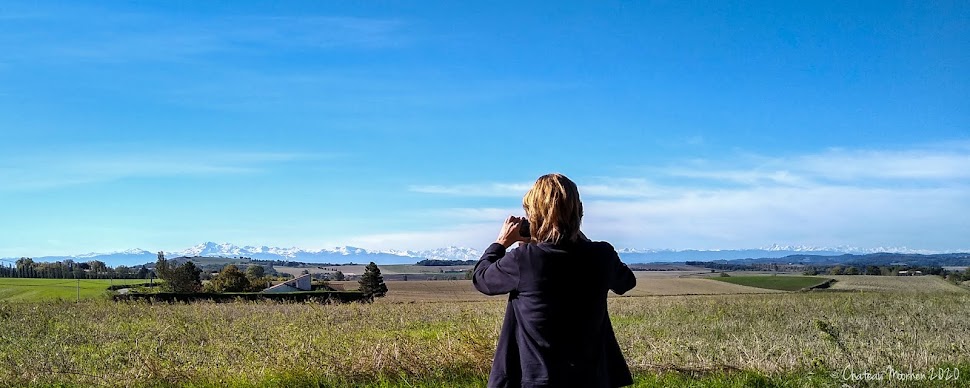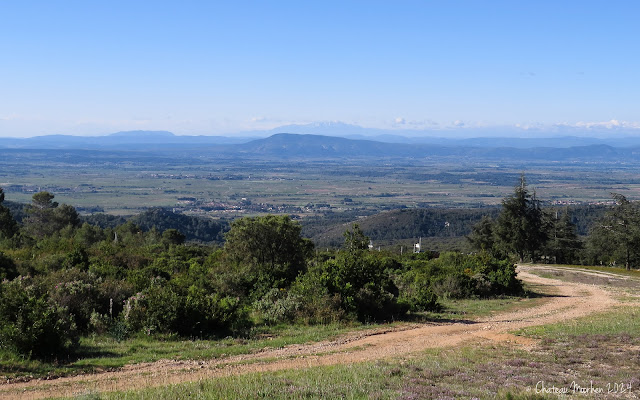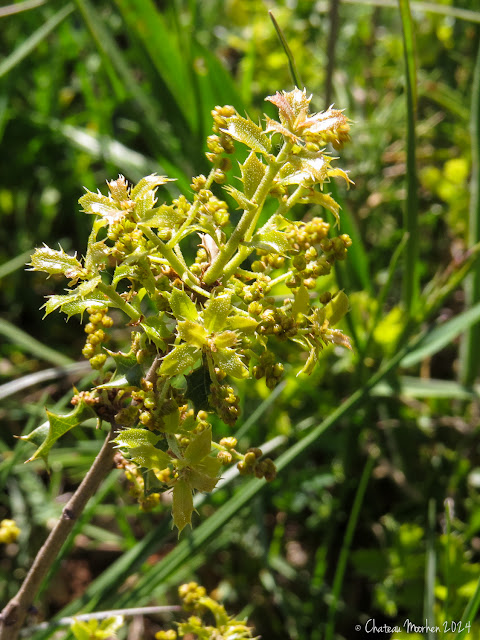This was a wildflower outing organised by Birding Languedoc last week, one that we had done before in May 2021. We started the day above the village of Siran in the Minervois. Due to firebreaks keeping the vegetation down it has allowed the wildflowers room to flourish without competition from the nearby trees and shrubs. This is garrigue habitat, where most plants grow low to the ground in rocky free draining soil, where they cope with hot dry summers due to small tough leaves, and/or summer hibernation.
There were only seven of us on the trip: Philippa who leads the BL trips and Gill who was our plant expert for the day. Also present were a couple of guys I know who are pretty knowledgeable about plants/birds/insects, so it made for an easier day with most plants fairly readily identified.
Whilst we had some great views over the plain to the Corbieres and distant Pyrenees, it was a very windy day so we were blasted by the cold wind until we could get to some more sheltered spots!
Being here a month earlier than the last time allowed us some fabulous displays of Asphodels (I don't know species name, possibly Asphodelus cerasiferus?).
My favourite garrigue plant is Cistus, particularly this Grey-leaved Cistus (Cistus albidus) with its lovely crinkly pink flowers. Also in this image is Thyme (Thymus vulgaris) which was everywhere, and Curry Plant. I hadn't realised that Curry Plant can be either Helichrysum italicum or H. stoechas. I thought they were one and the same plant! I can't tell which exact species were the ones we saw, that's impossible!
One of the stars of the day were these Pyrenean Fritillaries (Fritillaria pyrenaica).
Clockwise from top left: Rush-leaved Narcissus (Narcissus assoanus), Common Storksbill (Erodium ciconium), Perennial Lettuce (Latuca perennis) and White Rock-rose (Helianthemum apenninum).
A giant Puffball fungus well past its best.
Young shoots and flower buds of Kermes Oak (Quercus coccifera), the low growing oak found on garrigue habitat.
Thyme
We saw quite a lot of these Green-winged Orchids (Anacamptis morio) which were growing out in the open (photo on left), but only very few Provencal Orchids (Orchis provincialis) in more sheltered spots.
More Asphodels and Grey-leaved Cistus.
Our hardy wildflower loving group. 😀
We had our picnic in a sheltered spot nearby which was the only place where I saw butterflies, although one of our group spotted a few brave flutters hugging the ground during the day.
The afternoon's finds will be in part 2.
Chateau Moorhen..... goes south!
Now living in Aude in the Languedoc-Roussillon region
Blog Header

Friday 3 May 2024
Monday 29 April 2024
Spain Trip Oct 2023 - Part 5 Merida, Extremadura
Upstairs in the museum and the interior showed how impressive it was!
There were loads of statues and amazing mosaic floors.
Another example of a room with a mosaic floor with frescoes on the walls.
Back out into the town the next stop was the Temple of Diana - again restored, but much of the pillars are original stone. I prefer to see restored sites like this, showing how it really looked, than seeing the original stones just lying in place on the ground where they fell over the centuries. What's so interesting about this town is that modern life just goes on around most of these ancient sites. This site is on a modern day road with townspeople and tourists alike just walking and driving past, the former taking no notice, the latter in awe.
The Roman Forum. Ancient town, new town. I love this kind of thing!
The Puente Romano - the Roman bridge.
On the other side of the bridge was this stretch of Roman wall - I have no idea what it is relating to. Also in the collage is an invasive introduced species of terrapin from North America, the Red Eared Slider (Trachemys scripta elegans) and Cormorants sitting on the jetty.
On our walk back to the Moho, we passed the archaeological site of Moreria, which is excavating around the old city walls. I don't know which came first, the modern building or the archaelogical site. I suspect the latter, or there wouldn't be a nice space under the building for the dig.
The site was closed for the day as we walked past so I could only take some photos through the railings.
In this image I have lightened up the shadows so that the interior of the dig shows. There is really quite a large site underneath this building (or buildings).
And there we have the amazing town of Merida! This wasn't the last of our Roman visits during this holiday, but it was certainly the most incredible place we saw. Seeing all these ancient sites in place in the heart of a bustling modern day town made it so much more interesting and somehow easier to visualise how it was two thousand years ago. It was also a healthy day out - we walked about 7kms around the town!
We will certainly be going back to Extremadura as it was a most fascinating region, but the next trip post will come from - Andalucia!
There were loads of statues and amazing mosaic floors.
Another example of a room with a mosaic floor with frescoes on the walls.
Back out into the town the next stop was the Temple of Diana - again restored, but much of the pillars are original stone. I prefer to see restored sites like this, showing how it really looked, than seeing the original stones just lying in place on the ground where they fell over the centuries. What's so interesting about this town is that modern life just goes on around most of these ancient sites. This site is on a modern day road with townspeople and tourists alike just walking and driving past, the former taking no notice, the latter in awe.
The Roman Forum. Ancient town, new town. I love this kind of thing!
The Puente Romano - the Roman bridge.
On the other side of the bridge was this stretch of Roman wall - I have no idea what it is relating to. Also in the collage is an invasive introduced species of terrapin from North America, the Red Eared Slider (Trachemys scripta elegans) and Cormorants sitting on the jetty.
On our walk back to the Moho, we passed the archaeological site of Moreria, which is excavating around the old city walls. I don't know which came first, the modern building or the archaelogical site. I suspect the latter, or there wouldn't be a nice space under the building for the dig.
The site was closed for the day as we walked past so I could only take some photos through the railings.
In this image I have lightened up the shadows so that the interior of the dig shows. There is really quite a large site underneath this building (or buildings).
And there we have the amazing town of Merida! This wasn't the last of our Roman visits during this holiday, but it was certainly the most incredible place we saw. Seeing all these ancient sites in place in the heart of a bustling modern day town made it so much more interesting and somehow easier to visualise how it was two thousand years ago. It was also a healthy day out - we walked about 7kms around the town!
We will certainly be going back to Extremadura as it was a most fascinating region, but the next trip post will come from - Andalucia!
Wednesday 24 April 2024
Spain Trip Oct 2023 - Part 4 Merida, Extremadura
Moving further south but still in Extremadura is the town of Merida which is filled with amazing Roman ruins. It was an important town back in the day, called Emerita Augusta and founded in 25 BC in the region known as Lusitania. Water was brought to the city from Roman dams nearby via three aqueducts. This shows the size of the Roman city which was similar to the modern day population of nearly 60,000 people. The site has been a UNESCO World Heritage Site since 1993.
Acueducto de los Milagros (Aqueduct of the Miracles) is a remarkable structure, obviously not anywhere near as impressive as the Pont du Gard which is another aqueduct and bridge, but it still has many spans and levels standing. In the picture below is one of the White Stork's nests which are perched up on the top!
I rather wished I had visited this deli shop as we passed by as it looked very interesting.
A model showing the extent of the Roman town in the museum, which we visited later on. Here you can see the following things which we visited: top right outside the city walls is the Aqueduct of Miracles, bottom right are the theatre and the amphitheatre, in the centre are the forum and the Temple of Diana (though I don't know which is which) and on the left, the Roman bridge. The archaelogical site of Moreria is going north from the bridge along the lines of the old city walls.
We first visited the site of the theatre and the amphitheatre. This view is looking at the back of the theatre. There were various copies of statues dotted about; the originals were in the museum.
The amphitheatre. You can see the original seating tiers but there are of course modern stones here and there too - I know that the theatre is used for modern day plays but maybe the amphitheatre is used too.
The theatre - it has been restored in places but many of the stones/pillars are very well preserved.
This mosaic flooring was within the theatre complex and must have been part of a building but I don't recall the name. The walls are painted too.
After a break for lunch we visited the Museum of Roman Art - a modern building that looked rather boring from the outside, but was nothing of the sort on the inside. First we visited the vaults, and on the way down was this well preserved section of Roman road. The building was cleverly built over it.
Inside the vaults it was pretty dark so most of my photos were not worth sharing. There were all sorts of stones, pillars, stone coffins and bits of painted walls like here. I'm not sure if they have been moved from elsewhere - I assume so.
I will continue in the next chapter as we are only halfway through my photos from Merida - and they have been whittled down from well over a hundred as it is!
Acueducto de los Milagros (Aqueduct of the Miracles) is a remarkable structure, obviously not anywhere near as impressive as the Pont du Gard which is another aqueduct and bridge, but it still has many spans and levels standing. In the picture below is one of the White Stork's nests which are perched up on the top!
I rather wished I had visited this deli shop as we passed by as it looked very interesting.
A model showing the extent of the Roman town in the museum, which we visited later on. Here you can see the following things which we visited: top right outside the city walls is the Aqueduct of Miracles, bottom right are the theatre and the amphitheatre, in the centre are the forum and the Temple of Diana (though I don't know which is which) and on the left, the Roman bridge. The archaelogical site of Moreria is going north from the bridge along the lines of the old city walls.
We first visited the site of the theatre and the amphitheatre. This view is looking at the back of the theatre. There were various copies of statues dotted about; the originals were in the museum.
The amphitheatre. You can see the original seating tiers but there are of course modern stones here and there too - I know that the theatre is used for modern day plays but maybe the amphitheatre is used too.
The theatre - it has been restored in places but many of the stones/pillars are very well preserved.
This mosaic flooring was within the theatre complex and must have been part of a building but I don't recall the name. The walls are painted too.
After a break for lunch we visited the Museum of Roman Art - a modern building that looked rather boring from the outside, but was nothing of the sort on the inside. First we visited the vaults, and on the way down was this well preserved section of Roman road. The building was cleverly built over it.
Inside the vaults it was pretty dark so most of my photos were not worth sharing. There were all sorts of stones, pillars, stone coffins and bits of painted walls like here. I'm not sure if they have been moved from elsewhere - I assume so.
I will continue in the next chapter as we are only halfway through my photos from Merida - and they have been whittled down from well over a hundred as it is!
Subscribe to:
Posts (Atom)


































